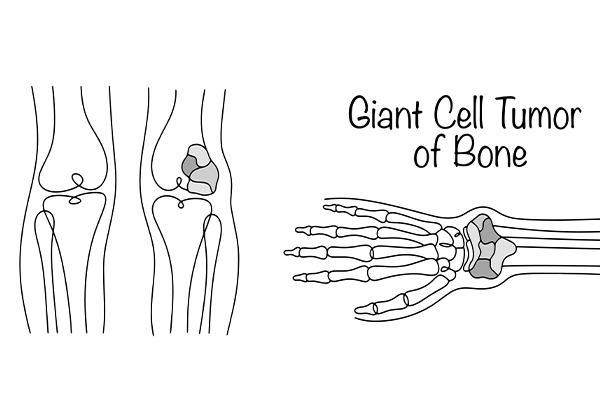
When a loved one hears the words “giant cell tumour of bone,” it’s natural for anxiety to set in. Questions flood the mind — What caused it? Will I be able to walk normally ever again? Is treatment painful? The reality is: an early and precise diagnosis, empathetic care, and bespoke treatment from our experienced orthopaedic doctors in Gurgaon can change the entire outlook. Here’s a comprehensive, human-centred guide for patients and families taking the first steps from diagnosis to recovery.
Synopsis
What is a Giant Cell Tumour of Bone?
A giant cell tumour of bone is a rare, generally benign tumour that favours the ends of long bones; think knees, wrists, or sometimes the spine. Despite being non-cancerous, it has a reputation for being locally aggressive. It would damage the bone tissues and cause severe pain, while, if ignored, it may also damage the joints or cause problems in movements.
Most giant cell tumours affect young adults, especially females in their twenties or thirties, in contrast to many bone tumours. Since it is not deemed a usual cancer, but because of this erratic behaviour and high chances of recurrence, it needs to be under the care of experts and their treatment. This is when our skilled orthopaedic experts in Gurgaon come into the picture, who not only support the patient medically but also morally.

Signs and Symptoms: Keeping Your Eyes Open For The Red Flags
No two cases will ever be alike; some early signs for the giant cell tumour of the bone are:
-
Deep aching pain in the joint, persistent and aggravated with use
-
Visibly evident swelling or lump over the bone area
-
Stiffness or difficulty in movement of the joint
-
Sudden, unexplained fractures (in case the bones are weakened)
These symptoms creep up gradually and are often mistaken for sports injuries or arthritis. However, if you experience prolonged troubling symptoms, it’s crucial to seek prompt assessment by our leading cancer care experts in Gurgaon, who are skilled in separating common complaints from rare diagnoses.
The Diagnostic Pathway: Imaging and Histology Explained
1. Giant Cell Tumour of Bone Radiology: Peering Inside
The initial work-up for a giant cell tumour of bone relies on advanced imaging. Giant cell tumour of bone radiology includes X-rays, which often show a characteristic “soap-bubble” appearance at the bone end. MRI and CT scans come next, clarifying the tumour’s size, how far it has spread, and whether the nearby joint or soft tissues are involved.
2. Giant Cell Tumour of Bone Histology: The Microscopic Diagnosis
Imaging provides a roadmap, but the final word rests with tissue analysis or histology. During a biopsy, a tiny sample of the tumour is removed and examined under a microscope. Giant cell tumour of bone histology is distinctive: countless multinucleated “giant” cells scattered among spindle-shaped stromal cells. This pattern helps distinguish the tumour from more dangerous bone cancers and guides our orthopaedic specialists towards the most effective treatment plan.
Treatment Options: Personalised Plans for a Brighter Future
Surgery: The Gold Standard
The mainstay of giant cell tumour of bone treatment is surgery — removing the tumour while preserving as much healthy bone and joint as possible.
The most common technique is curettage, where the tumour is meticulously scraped out and the cavity is filled with bone cement, graft, or synthetic material. For more extensive tumours, part of the affected bone may need excising, followed by reconstruction using prosthetics or bone grafts.
Skilful surgical intervention by our expert orthopaedicians ensures the best possible outcomes, balancing tumour eradication with mobility and quality of life.
Advanced Therapies: Medication and Radiotherapy
For tumours in tricky locations or those that prove resistant to surgery, targeted medications can shrink the growth and facilitate successful removal. Radiotherapy may be reserved for patients where surgery is not feasible, though it’s not a first choice due to possible side effects.
Our orthopaedicians in Gurgaon put every therapy option on the table — tailored specifically to each person’s age, activity level, and goals.
The Recovery Journey: Rehabilitation and Monitoring
Recovery from a giant cell tumour of bone doesn’t end in the operating theatre. Physiotherapy begins soon after surgery, aiming to restore movement, reduce pain, and build confidence. Most patients will need crutches or supports early on, gradually regaining strength and function.
Regular follow-up is essential. Giant cell tumours can sometimes recur, usually within three years after initial treatment.
Emotional healing is equally important. Facing months of worry and hospital visits, many patients and their families find comfort in support groups or individual counselling. Our compassionate professionals in Gurgaon champion whole-person care — you’re not just a diagnosis, but a unique individual on the path to renewed wellbeing.
Living Well After Giant Cell Tumour
The long-term outlook for most patients is positive. With expert care, most people return to work, sports, and the activities they love. A handful may deal with stiffness or altered joint mechanics, but with physiotherapy and modern surgical techniques, limitations are usually minor.
What matters most is not journeying alone. Our orthopaedic doctors in Gurgaon walk with you, from diagnosis to recovery and beyond, uniting technology, experience, and genuine compassion in every encounter.
FAQ's
A giant cell tumour of bone is a benign but locally aggressive tumour, most commonly developing at the ends of major long bones. It can cause pain, swelling, and bone damage if not treated.
Diagnosis hinges on imaging (giant cell tumour of bone radiology, such as X-rays and MRI) and tissue analysis (giant cell tumour of bone histology), interpreted by our skilled specialists.
Surgical removal (curettage or bone excision) is the primary treatment, sometimes supported by advanced medication or radiotherapy for difficult cases.
Yes, recurrence is possible, especially in the first few years, which is why regular follow-up and monitoring by our professionals is essential.
Most people make an excellent recovery, especially with early intervention and rehabilitation. Any lingering movement issues are usually manageable with support from our extensive care team.





















 5 Min Read
5 Min Read



















